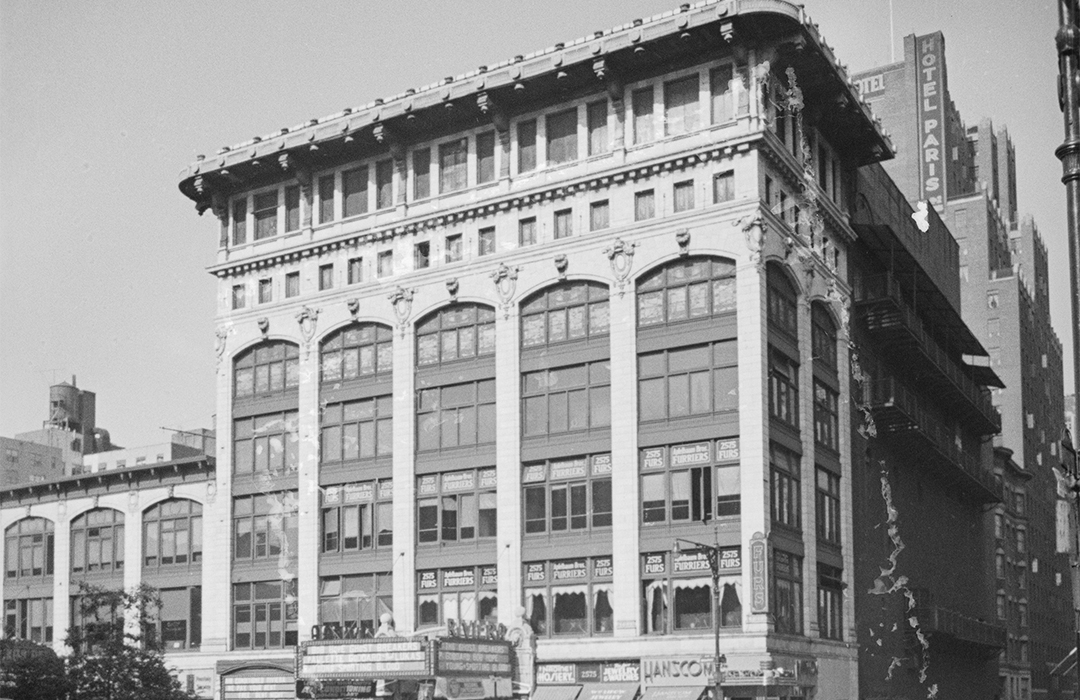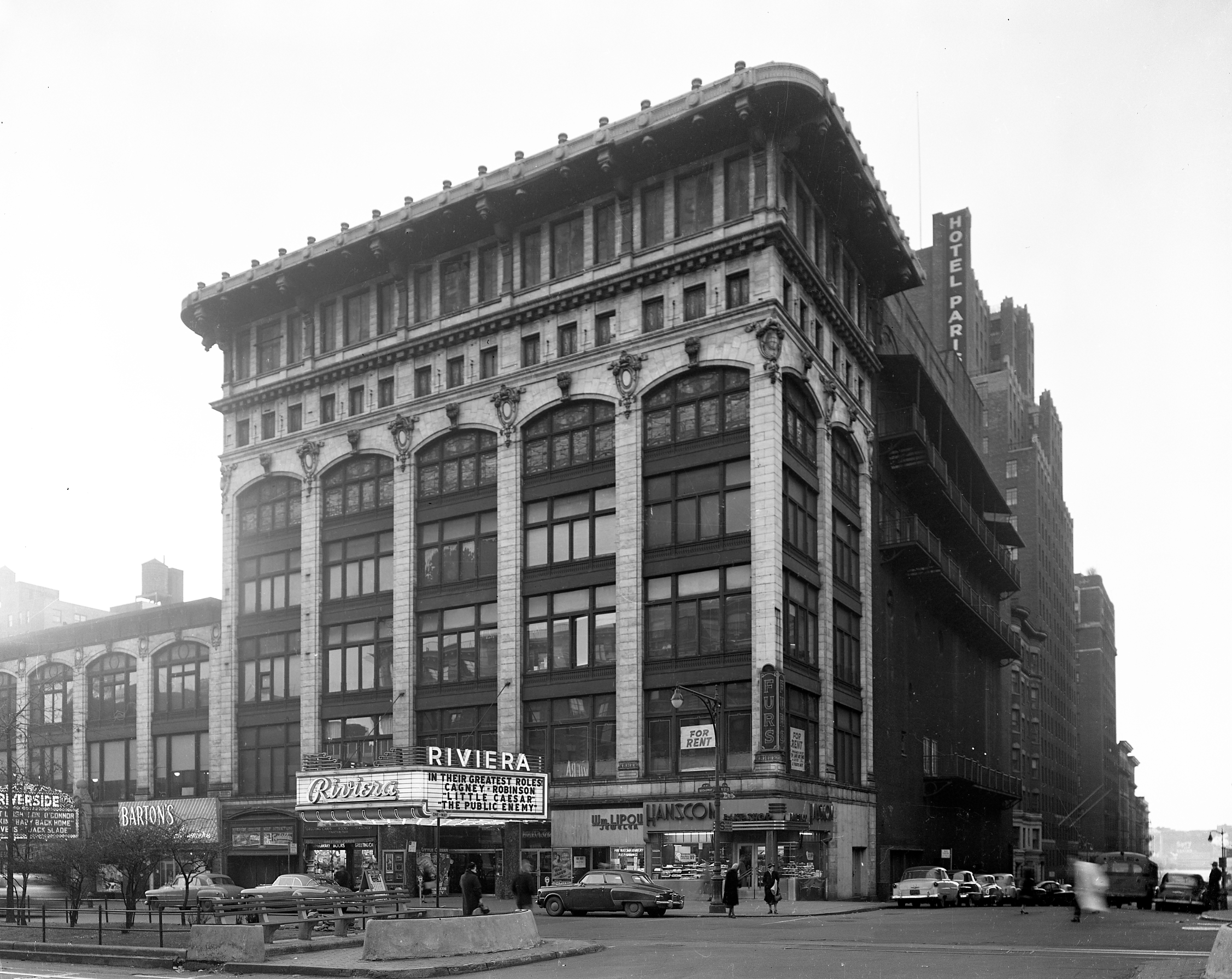
The Riviera Theater
by Tom Miller
On February 8, 1913, the Real Estate Record & Guide wrote, “The past two years have been years of unusual progress for theatre building in Manhattan.” The article noted “the marked success of Marcus Loew and William Fox” was leading other theatrical managers to build, as well. And, indeed, William Fox was erecting theaters at a dizzying pace.
Three months after the article, Fox hired architect Thomas Lamb to design what was originally planned to be a “two-story theatre and store building” at the southwest corner of Broadway and 97th Street. Called the Riviera, it would be just one block to the north of Fox’s Riverside Theatre, at 96th Street. Fox was very familiar with the man who was by now perhaps the foremost American theater designer of the period. Thomas Lamb’s first commission for a motion picture theater had come from William Fox in 1909. Before Lamb’s death in 1942, he would design more than 170 theaters.
By the time the Riviera Theatre was completed in 1914, the two-story structure had grown to seven, with six stories of office and commercial space above the theater. Lamb’s Beaux Arts design featured vast expanses of glass, a profusion of terra cotta ornamentation, and a deeply overhanging cornice with rounded corners.
The second floor of the building held a dance floor. In January 1914, as the building neared completion, Fox leased the third floor to John B. Halliday “for a billiard parlor,” and one of the ground floor stores to the Hartford Umbrella Company. In December Hyman W. Edson, after having worked for other jewelers for years, opened his own jewelry store in the building. (Sadly, his business went bankrupt a month later.)
The Riviera offered “Vaudeville and Photoplays,” according to an advertisement, meaning that silent movies were accompanied by live entertainment. Ticket prices in 1916 ranged from 15 cents for the balcony to 50 cents for box seats. (The most expensive equaling $12.50 today.) Matinee prices were half that. Silent films were accompanied by a Moller organ, installed in 1917 at the staggering cost of more than $111,000 today.
The Shubert brothers managed the largest theater empire at the time with more than 80 theaters in the United States.
On August 2, 1918, The New York Times reported, “It was announced yesterday by the Shuberts that they had taken over the Riviera Theatre, at Broadway and Ninety-seventh Street, and that the house would hereafter play first-class attractions for periods of one week…The theatre has been operated by William Fox as a picture house for the last five years. It will be known as the Shubert Riviera.”
The Shubert brothers managed the largest theater empire at the time with more than 80 theaters in the United States. Under their management, the Shubert Riviera offered legitimate theater, bringing plays to the Upper West Side that had already been seen on Broadway. And they introduced a clever scheme of ensuring continued patronage. An advertisement in the New-York Tribune on August 11, 1918 touted, “Subscriptions Accepted Now.”
A highly visible tenant leased the entire third floor in October 1920. The Pelman Institute, Inc. “which has branches throughout Europe,” according to the Record & Guide, moved its offices from 505 Fifth Avenue. The Pelman Institute offered courses in self-betterment. An advertisement in The Independent and The Weekly Review in 1922 explained in part:
The extraordinary rush for Pelmanism that marks the present year is still continuing…Copies of the latest edition of ‘Mind and Memory’ (containing full particulars of the Pelman Course) are now being sent daily to all parts of the world. Readers who wish to grasp opportunity by Pelmanizing their minds, thereby doubling and trebling their efficiency, can obtain a copy of this book free by sending the coupon printed on this page to the Pelman Institute, 2575 Broadway, New York City.
By 1926 the Pelman Institute had branched out with The Pelman Language Institute. The peculiar method of learning French, Spanish, or German was simply to read, by correspondence course, one lesson a night that did not contain a word of English. The theory was that, just as the student had learned English as a child “by habit instead of by rule,” he would add “new words to [his] foreign language vocabulary” nightly. An advertisement promised, “In 8 to 12 weeks you speak, write, and read well enough for any native to understand.”
In the meantime, the Shubert Riviera continued to offer plays that had been staged downtown. On September 18, 1921, for instance, the New York Herald reported on the opening of Spanish Love “that ran last season at Maxine Elliott’s Theatre.” A week later, Enter Madame opened. The New York Herald remarked, “The play originally was produced at the Garrick Theatre and played at two other Broadway houses.”
The real estate office of the Riverside Property Owners occupied space on the second floor in 1930. At 11:15 on the morning of December 31, “three young bandits,” as described by The Brooklyn Daily Eagle, walked in, two of them brandishing pistols. They forced the bookkeeper, 24-year-old Goldie Schorr, to open the safe, then “bound her hands and feet,” escaping with the payroll of $1,600. Thieves were keenly aware that employees were paid in cash, and by watching the patterns of an employee’s weekly trips to the bank and back could accurately plan a heist like this. Schorr told police she had just returned from the bank with the cash an hour earlier. The following month, on January 20, the crooks were captured after police “ran them to cover in a furnished room at 214 West Ninety-first street,” according to The New York Sun.
The Shubert Riviera was still a legitimate theater during the Depression years. On March 29, 1932, The New York Times reported that Charles Winniger would head the cast of The Music Master. The article reminded readers, “Mr. Winniger will be seen in the role made famous by David Warfield in the late David Belasco’s production of the Charles Klein play in 1904.”
One of the upper floor spaces at the time was home to a photomaton studio in the mid-to late 1930s. The photomaton was the forerunner of the ubiquitous coin-operated photo booths seen throughout dime stores and shopping malls in the latter part of the century. Annie’s Photos operated here (possibly in the same space) in the following decade, offering four different poses for graduate school applications for 75 cents.
As they neared the night depository at 10:15, a robber pointed a gun concealed in a newspaper and snatched both men’s envelopes.
In 1948 the Skouras chain of theaters took over the Riviera and returned it to a motion picture house. The theater was closed and completely “renovated and refurbished,” according to The New York Times. The gala reopening ceremony took place on February 9, 1949, with the screening of The Life of Riley, “an as yet unreleased University-International film, starring William Bendix,” said the newspaper. According to William A. White, the general manager of the Skouras chain, the redecorating came at “an expense exceeding the half-million-dollar mark.” Deputy Mayor John J. Bennett officiated at the reopening.
The problem of thieves targeting employees on bank runs still loomed in the 1960s. For that reason, the manager of the Riviera Theatre and the manager of the Riverside Theatre routinely walked together with the nights’ receipts to the First National City Bank at 2564 Broadway across the street. But on the night of March 27, 1966, their plan failed. As they neared the night depository at 10:15, a robber pointed a gun concealed in a newspaper and snatched both men’s envelopes. He ordered them to “face the wall,” then fled with a total of $3,953—around $33,000 in 2023 money.
By 1970 the venue was the United Artists Riviera Theatre. As the “Fight of the Champions” neared in February 1971, the Rivera came up with a brilliant marketing gimmick. The boxing match between Joe Frazier and Muhammad Ali was going to be a sensation. On February 7, an advertisement touted, “Exclusive, Live Closed-Circuit Giant Theatre Screen TV!” Rather than watch the broadcast on their small home television sets, boxing fans could enjoy it from the comfort of theater chairs on a huge screen.
At the time of the match, the Manhattan Haitian Neighborhood Center operated from an upper floor. It provided aid to newly arrived Haitians in applying for government benefits, filling out forms, and other processes. The center also offered job placement services.
The end of the line for Thomas Lamb’s striking building was on the horizon, however. It was soon demolished to make way for the beige brick apartment building that was completed in 1983.
Tom Miller is a social historian and blogger at daytoninmanhattan.blogspot.com
BUILDING DATABASE
Keep Exploring
Be a part of history!
Think Local First to support the businesses at 2571-2579 Broadway:



